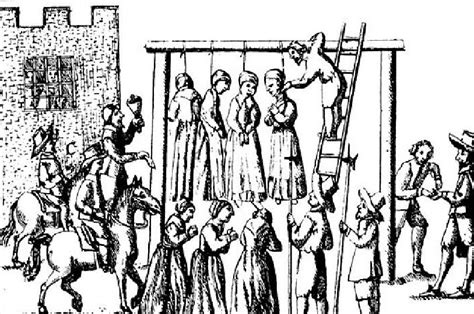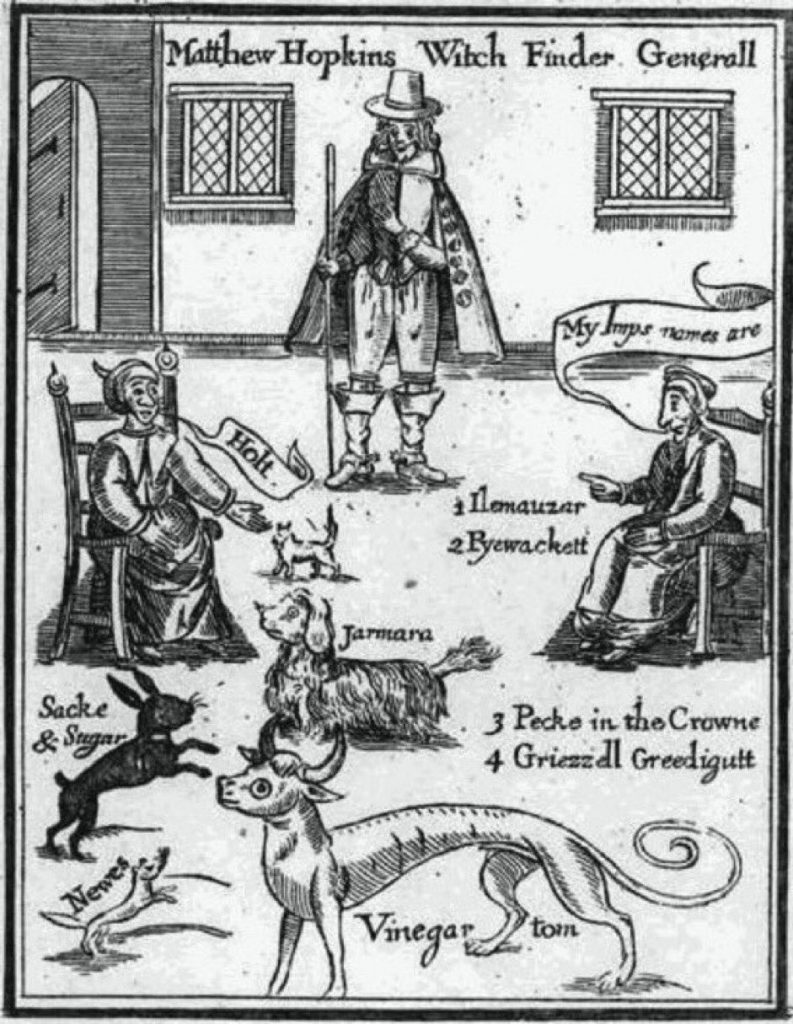Are You A Witch?

Let me ask you some personal questions. Do you live in East Anglia? Do you have any moles on your skin or other marks? If you were thrown into some deep water, would you float? If your answer to the above questions is, “Yes,” and if you are female, the chances are that you might have been found to be a witch in the seventeenth century.
Of course, if I were being paid a considerable sum to clear the town of witches, and if there was any doubt about whether or not the accused was a witch, the use of torture could always extract a confession and resolve the issue.
The Witchfinder: Matthew Hopkins
In 1646 Matthew Hopkins was asked to clear King’s Lynn of witches. The town leaders agree to pay £15, though that was later upped to £17. (He had previously been paid £23 for clearing Chelmsford.) The average worker was only earning 2.5p a day.
Hopkins was born in Suffolk at the beginning of the seventeenth century. Some people think he was trained as a lawyer because of the way he presented his evidence in court. He called himself the “Witchfinder General” (although that title was never given to him by parliament – and he was not a man to let truth get in the way of good PR). He operated mainly in Suffolk, Essex, Norfolk, Cambridgeshire and Huntingdonshire, with a few visits in the counties of Northamptonshire and Bedfordshire.

Hopkins began his career in March 1644 when he allegedly first discovers six witches in Manningtree, claiming they tried to kill him. He soon goes about East Anglia getting people to hire him to hunt out witches, force their confessions, and have them hanged by the authorities.
We need to bear in mind the historical and religious context that Hopkins was working in. The Church of England’s break from Catholicism in the previous century led to religious fragmentation and increased suspicion towards individuals seen as non-conformists. Puritans, seeking a “pure” society, emphasised the battle between good and evil, often identifying witches as agents of the devil. This attitude fuelled witch-hunts, particularly during the English Civil War when Puritan authority was strong. Hopkins was a sincere, zealous Protestant, but he exploited local anxieties about purity and morality.
Hopkins is believed to have been responsible for the executions of over 100 alleged witches between the years 1644 and 1646. He and his colleague (John Stearne) sent more accused people to the gallows than all the other witch-hunters in England of the previous 160 years.
Hopkins died in 1647 of tuberculosis and was buried on 12 August in Manningtree. However, before his death he published his book, The Discovery of Witches. This led to witchhunting in the New England Colonies which lasted until 1663, and some of his methods were used in the Salem Witch Trials of 1692-93.
Finding Witches: The Methods
Initially people had to be identified as possible witches, and once that had been achieved, there were at least three common methods designed to prove that the person was a witch. The criteria for identifying possible witches are plentiful and arbitrary (though the person was usually female). The people identified could be old, or insane, or suffering some from physical or mental health difference. They could be perfectly “normal” but could have uttered an unfortunate curse, or been in close proximity to some death or tragedy. They could simply be a difficult neighbour or just someone that none of the immediate community liked.

The tests to find out if (or prove) a person was a witch were:
- Having a mole of skin deformity which could serve as an extra teat for suckling imps. If insensible when pricked, this proved the person was guilty.
- Forcing the accused to walk about until they collapsed. As witches can apparently only summon evil spirits when still and resting, the act of sitting down to rest would prove guilt.
- Binding, and flinging the accused into water. Witches apparently deny their baptism and so are repelled by the water and float rather than sink.
- So called “spectral” evidence. It was believed that witches visited people in dreams, so someone recounting their dreams could have it used against them. The alleged victims of witchcraft would claim to have been tormented by the spectral images of certain named members of the community; this was taken as evidence that those named were witches, and had given the devil permission to assume their appearance.
- A method that was sometimes employed (certainly in Scotland and parts of Europe, if not in Lynn) was that of using the large public scales in trade halls to weigh the accused women. The belief was that witches were magically lighter than honest women. A false belief, together with incompetence or corruption led to many innocent women being burned.
The Alleged Witches of Lynn
On 11 May 1646 Edward Robinson sent Captain Rivett to Huntington to ask if Hopkins would come to Lynn. He arrived in August and was given a formal greeting as a drummer was paid to escort him and drum him through the streets of the town as a conquering hero. Hopkins went to the gaol (the converted undercroft of the town hall) and found nine women and one man who were suspected of witchcraft. All had been committed to trial after a panel of midwives and honest matrons had found suspicious marks on them.
Hopkins was back in Lynn for the trial on 24 September. Miles Corbett (a later regicide who would be hung, drawn, and quartered) was the recorder for the town. Grace Wright, Cecily Taylor, Katherine Banks, Emma Godfrey, and Lydia Browne, all widows, were charged with witchcraft, as were Dorothy Griffin, Thomasine Parker, Dorothy Lee, and Thomas Dempster. The outcome was not what Hopkins had intended. In fact, it was almost the reverse of what had happened at Huntington. Of the nine accused witches, six were acquitted and one was judged to be non compos mentis. Only Grace Wright and Dorothy Lee were sentenced to be hanged in the town’s Tuesday Market Place.
Witchcraft trials failed if the accuser was shown to be fraudulent, or if there wasn’t sufficient evidence, or if there was a natural medical explanation. Just before Hopkins retired, he was questioned by some justices of the assizes about whether the methods used were torture, and whether the witchfinders themselves were witches because of the secret knowledge they seemed to have.
You can see from the dates below that witches were being found in the town before and after the arrival of Hopkins. Despite his fee, Hopkins appears not to have been too successful (thankfully), although it is possible that some records may have been lost. The last execution in England for witchcraft was 1685.
- 1583 Mother Gabley, hanged
- 1590 Margaret Reed, burned
- 1598 Elizabeth Housegoe, burned or hanged
- 1617 Mary Smith, hanged
- 1646 Dororthy Lee, hanged
- 1646 Grace Wright, hanged
- 1650 Dorothy Floyd, hanged
- 1651 Dorothy Hellhouse, hanged
Two Problematic Lynn Legends: Margaret Read, Mary Smith
Margaret Read (also spelled Reed) was apparently burned at the stake in King’s Lynn in 1590, accused of witchcraft. Burning for witchcraft was exceptionally rare in England; it was normally reserved for petty treason (such as murdering a husband). In Read’s case, witchcraft appears to have been the alleged attendant crime. A persistent legend says that her heart exploded and struck a building in Tuesday Market Place, leaving a mark that still exists (though the current building and the mark date from a century later).
Mary Smith was hanged in 1617 at King’s Lynn for witchcraft (some sources say 1616/1617). Hanging, not burning, was the usual punishment in witchcraft cases in England. She was known locally for alleged curses causing illness, including against Elizabeth Hancock after a dispute. Hancock consulted a local “cunning-man” whose testimony formed part of the case. At her trial, local magistrates and ministers put pressure on her until she confessed to making a pact with the Devil, describing him as a black man with horns.
In certain retellings, her heart is said to have burst from her body and scorched the house of her principal accuser – though the present building is much later and likely postdates the execution.
Both cases illustrate how legend and folklore (such as exploding hearts) have outlasted verifiable legal detail.
The primary source on Mary Smith’s trial in King’s Lynn (c. 1616/17) is a pamphlet authored by Alexander Roberts, preacher at St Margaret’s in King’s Lynn. It was published around the time of the execution and offers rare contemporary detail on accusations, confession, and trial procedures.
The pamphlet records:
- Local accusations—especially by Elizabeth Hancock—alleging Mary cast curses that caused illness after disputes and perceived wrongs.
- Consultation with a “cunning‑man” to counteract the supposed witchcraft, with his testimony playing a role in the case.
- Under pressure, Mary confessed to a devil’s pact (describing the Devil as a horned black man), as documented by Roberts..
- She was executed on the same day her trial concluded, consistent with some law-book accounts.
© James Rye 2023
See also:
Book a Walk with a Trained and Qualified King’s Lynn Guide Through Historic Lynn
Sources
- Gaskill,M. (2005) Witchfinders: A Seventeenth-Century English Tragedy, John Murray
- Hillen, H.J. (1907) History of the Borough of King’s Lynn, Vol.1, EP Publishing Ltd
- Mitchell, C. & Venditozzi, Z. (2025) How to Kill a Witch: A Guide for the Patriarchy, Monoray
- Richards, P. (1990) King’s Lynn, Phillimore
- Roberts, A. (1616) A Treatise of Witchcraft. Wherein sundry Acts of Witchcraft are faithfully recorded. Declaring the true manner and order of the proceedings against Mary Smith, who was executed at King’s Lynn in Norfolk, in the year 1616. By Alexander Roberts, preacher of God’s Word at King’s Lynn, Nicholas Okes
- https://earlofmanchesters.co.uk/who-was-matthew-hopkins-the-witchfinder-general/
- https://www.historic-uk.com/HistoryUK/HistoryofEngland/Matthew-Hopkins-WitchFinder-General/
- https://norfolkrecordofficeblog.org/2018/10/31/the-witches-of-lynn/
- https://en.wikipedia.org/wiki/Matthew_Hopkins
- https://uolcss.blogs.lincoln.ac.uk/2018/11/02/a-legal-history-of-witchcraft-in-the-uk/

[…] See also The Alleged Witches of King’s Lynn. […]
[…] Thankfully it would appear that when Matthew Hopkins (the self-styled Witchfinder General) was called to the town in 1646, he only managed to find two witches, despite being paid a lot of money, and despite having so-called “fool-proof” methods (see The Alleged Witches of Lynn). […]